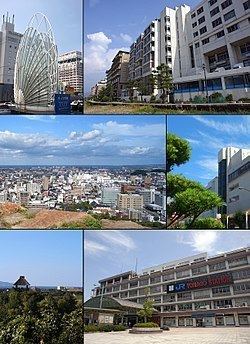Country Japan Region ChugokuSanin | Population 148,271 (2010) Area 132.21 km2 | |
 | ||
University Tottori University, Yonago Mayor Yasuo Nozaka (since April 2003) | ||
Map of Yonago, Tottori
Yonago (米子市, Yonago-shi) is a city located in northwestern Tottori Prefecture, Japan, facing the Sea of Japan, and adjacent to Shimane. It is the prefecture's second largest city after Tottori, and forms a commercial center of the western part of this prefecture.
Contents
- Map of Yonago Tottori
- Tottori japan kofu yonago rice reaping sand museum kurayoshi daisen
- Going back from osaka to yonago by nightcoach
- Etymology
- Transportation
- History
- Climate
- References

As of June 1, 2016, the city has an estimated population of 149,210 and a population density of 1,100 persons per km2. The total area is 132.21 km2.

The current city was administratively founded on April 1, 1927, and absorbed the town of Yodoe (from Saihaku District) on March 31, 2005. It is home to the Yonago City Museum of Art. Since the city has begun to develop into a trade center of note, it has acquired the nickname Osaka in San-in.
Tottori japan kofu yonago rice reaping sand museum kurayoshi daisen
Going back from osaka to yonago by nightcoach
Etymology
The name of Yonago in the Japanese language is formed from two kanji characters. The first, 米, means "rice", and the second, 子 means "child".
Transportation
Yonago has always been an important crossing point of several routes in the area. Yonago Station serves three railway lines. The city also has a seaport to the Oki Islands. Miho-Yonago Airport, located in a neighboring city of Sakaiminato, serves the area.
History
The Amago clan, daimyo of the Sengoku period, constructed Yonago Castle in the area at the beginning of the 17th century. In the Edo period, the castle was kept by a castellan who served the Ikeda clan of nearby Tottori Castle.
Climate
Yonago has a humid subtropical climate (Köppen climate classification Cfa) with hot summers and cool winters. Precipitation is significant throughout the year, with July and September being particularly wet months.
